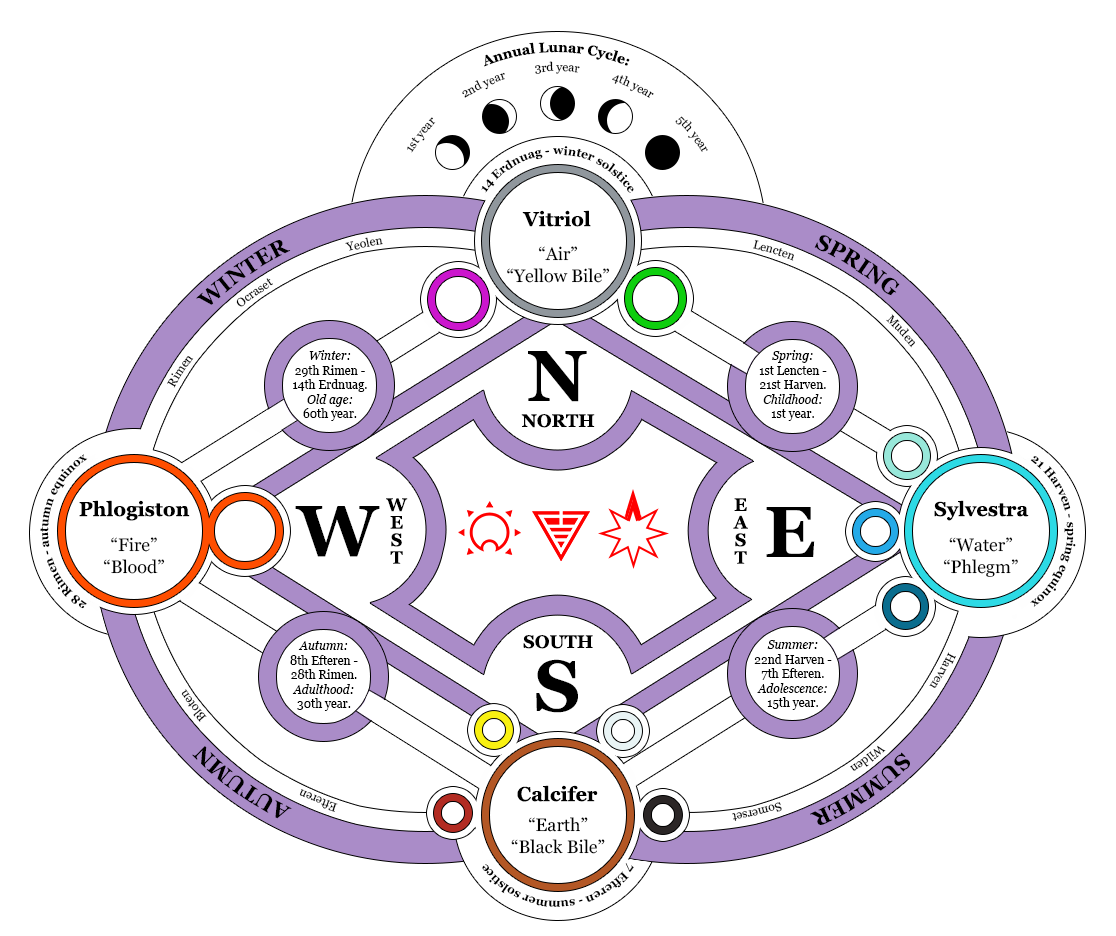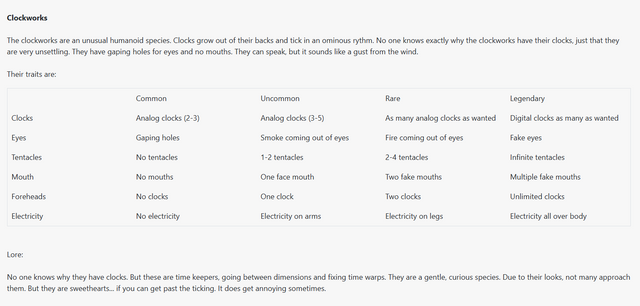HOME | DD
 kerog6 — Ramul Thran - Months, Elements, and Cycles
by-nc-nd
kerog6 — Ramul Thran - Months, Elements, and Cycles
by-nc-nd

#atlas #ramulthran #diagram #elements #fantasy
Published: 2017-05-16 05:33:26 +0000 UTC; Views: 797; Favourites: 6; Downloads: 4
Redirect to original
Description
On the years, months and seasons: Every solar year is 364 days, and every lunar month is 35 days. There are ten calendar months in a year, making up 350 days. The final 14 days stand apart from the months and together are known as Erdnuag. There are four seasons, each encompassing 91 days or three-fifths and two lunar months.
On the lunar cycle: There are eight distinct phases of the moon, but five are significant: Waning Gibbous, Waxing Crescent, Waning Crescent, Waxing Gibbous, and New Moon. On the first day of the year, the moon will only rise bearing one of these phases, and during any five-year cycle all of these phases will be seen on this day in this order.
On the elements: There are four elements and ten elemental forms. The first element is Phlogiston, once known as “Fire” [1], and it has one form by the same name. The second element is Vitriol, once known as “Air” [2], and it has two forms: Miasma and Anima. The third element is Sylvestra, once known as “Water” [3], and it has three forms: Air, Water, and Ice. The fourth element is Calcifer, once known as “Earth” [4], and it has four forms: Mercury, Glass, Iron and Gold.
Alternate names are given in these languages: Quen'hel, Talular, and No-Udos, in this order:
[1] Or: Naur, Ziril, Sute;
[2] Or: Vilya, Kaze, Haize;
[3] Or: Alu, Arel, Ura;
[4] Or: Arda, Ber, Lurra.
On Phlogiston: The element of burning, having a gas-like pure form. It inhabits flammable and living material and is released into air or water in extreme heat, creating fire, or during exhalation. Once into the air or water, growing plants absorb the phlogiston. Exhaling takes phlogiston away from the body, allowing life to continue. In a sealed environment, flames and breathing things alike die due to a lethal accumulation of phlogiston in the air. Likewise, plants cannot survive in a seal, for the reverse reason – lack of phlogiston.
On Vitriol: The element of spirit, having two pure forms. However, these forms are only theoretical, and the creation or discovery thereof is known as the Magnum Opus, the greatest of the great works. Despite being one of the least-understood alchemical elements, limited manipulation of Vitriol is indeed possible, and is believed to have been commonplace before the Year of the Sun.
On Sylvestra: The element of air, water and ice, having three pure forms. When in liquid or gas form it acts as a solvent in alchemical reactions, providing a medium through which phlogiston and calcifer can interact. When in solid form it removes all potential for reactions, as without water or air no such reactions can take place.
On Calcifer: The element of minerals, consisting of four pure forms, or calxes. They inhabit stone and liquefy when exposed to extreme heat. Small concentrations are found within all living things, especially in the bones of animals, and gives strength and form to them, as it does to all other solid material.
- - - - - - -
A diagram that (hopefully) explains various natural and metaphysical aspects of the world of Ramul Thran. The ultimate goal in mind, as I do all this, is to create a miniature atlas of my world, and what atlas is complete without weird diagrams about astrology and alchemy?
A meta-note about the elements: While everything else is read clockwise, they are read counter-clockwise, so when it says Calcifer has Mercury, Glass, Iron and Gold, it's describing the black, white, yellow and red circles respectively. And yes, that means Iron's circle is yellow and Gold's circle is red. Shouldn't they be the other way, you might ask? No. That's alchemy for you.

























